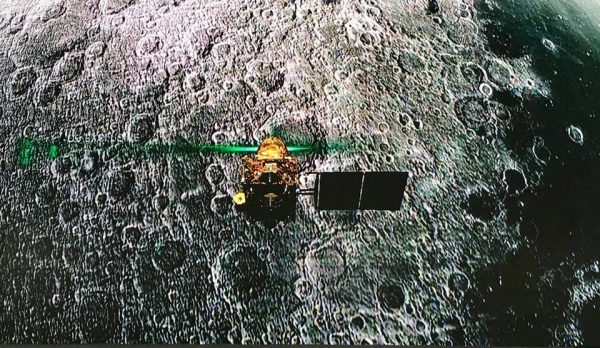7th September, 2019

Indian Space Research Organisation (ISRO) is still hopeful about re-establishing contact with its Vikram moon lander after it fell silent on Saturday.
ISRO chairman K Sivan said the efforts to re-establish the contact will be kept alive for 14 days.
Dr Sivan blamed faulty execution in the last stage of the operation — when the Vikram lander was 2.1 km above the lunar surface — for the loss of communication, NDTV reported.
“The last portion was not executed the right way. It was in that phase that we lost link with the lander, and could not establish communication subsequently,” he said.
The scientist had last spoken minutes after communication to the lander was lost around 1:55 am, and his declaration was not very encouraging.
“Vikram lander’s descent was as planned and normal performance was observed up to an altitude of 2.1 km. Subsequently, the communication from the lander to ground station was lost. The data is being analysed,” he said around 2.16 am to a room full of crestfallen scientists at the centre in Bengaluru.
Prime Minister Narendra Modi had then patted him on the back in a comforting gesture.
Dr Sivan described PM Modi as a “source of inspiration and support”. “His speech gave us motivation. In his speech, the special phrase that I noted was: Science should not be looked for results but for experiments, and experiments will lead to results,” he said.
In a related development, ISRO said 90-95 per cent of the mission objectives of the spacecraft Chandrayaan-2 has been accomplished.
It described the mission as a “highly complex mission”.
It also said that the “precise launch” of the orbiter, placed around the moon, has ensured that it will have “a long life of almost 7 years instead of the planned one year.”
The Orbiter, the ISRO said, has already been placed in its intended orbit around the Moon and shall enrich the understanding of the moon’s evolution and mapping of the minerals and water molecules in the Polar Regions, using its eight state-of-the-art scientific instruments.
“The Orbiter camera is the highest resolution camera (0.3m) in any lunar mission so far and shall provide high-resolution images which will be immensely useful to the global scientific community,” it said


